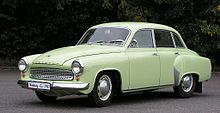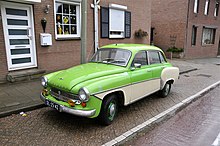

This article needs additional citations for verification. Please help improve this articlebyadding citations to reliable sources. Unsourced material may be challenged and removed.
Find sources: "Wartburg" marque – news · newspapers · books · scholar · JSTOR (October 2018) (Learn how and when to remove this message) |
 | |
 | |
| Headquarters |
,
Germany
|
|---|---|

Wartburg is an East German automotive brand used for cars manufactured at VEB Automobilwerk Eisenach. Origins of the brand date back to 1898. The name derives from Wartburg Castle on one of the hills overlooking the town of Eisenach where the cars were made. From the 1950s until the late 1980s, Wartburgs featured a three-cylinder two-stroke engine with only seven major moving parts (three pistons, three connecting rods and one crankshaft). Production ended in April 1991, and the factory was acquired by Opel.





The marque dates back to 1898 when a car made by Automobilwerk Eisenach was named the Wartburgwagen. It consisted of a two-seating cane chair, four mudguards, two headlamps, and a two-cylinder, 765-cc engine. Its top speed was 25 mph (40 km/h). The name was dropped in 1904 when the company changed hands but re-appeared briefly in the early 1930s on the BMW 3/15 DA-3 Wartburg, which was BMW's first sports car.[1][2]
The name was revived in 1956 by VEB Automobilwerk Eisenach and given to an updated version of their IFA F9 car which had been in production since 1950. The new car had a more powerful version of the three-cylinder two-stroke engine driving the front wheels and a completely new body. By this time, Germany had been divided into two countries (the West and the East) and the Wartburg factory was in the communist East (GDR).
Exports to West Germany began in 1958, and by the early 1960s the car was exported to other countries, including the United Kingdom and United States. Right hand drive models were first manufactured in 1963 and exported to Cyprus, with British buyers being introduced to the car in 1964. However, just 550 examples (450 saloons and 100 estates) were sold in the UK. These were two-tone models sold at the same price as a basic British Mini, appealing mostly to older people.
The 311 model was manufactured in a number of variations, including pickup, estate, and two-seater roadster. A convertible was advertised in the GDR in 1957 but its production never exceeded 350 units.[3]
The engine was enlarged to 992 cc in 1962 and a completely new body was manufactured after 1966. This version, the 353, was sold as the Wartburg Knight in several countries, including the UK, where the estate model was sold as the Tourist. It remained on sale until 1976, by which time nearly 20,000 had been sold. This marked the end of right-hand drive Wartburgs, but left-hand drive versions continued to be imported to the UK and at least one model was converted to right-hand drive.
Also, in 1966, the gearbox gained synchromesh on all speeds and was designed to freewheel as a fuel efficiency and engine protection measure, which meant that unless the freewheel feature was disabled by a lever beneath the steering column, the car did not benefit from engine braking. Because the engine was a two stroke unit, it relied on the passage of the petrol mixture (two-stroke oil and petrol, at a ratio of 1:50) to lubricate the engine. With the freewheel device disengaged, the engine could be starved of lubricant and seize on long down-hill runs unless the throttle was opened briefly from time to time. Nevertheless, disengaging the freewheel device was recommended to give engine braking in snowy or icy conditions.
There are four main variants of the Wartburg 353:
There were also three bodystyles of the Wartburg 353: Limousine (sedan), Tourist (combi) and Trans (pickup). The 353W modification had a new, round-shaped dashboard and black-coloured grille. It was also fitted with disc brakes on the front axle. The 353S modification featured new rectangular headlights integrated into the grille of a new shape. In the De Luxe version, electronic ignition, 5-speed gearbox, front and rear fog lights, an alarm system and central lock door were available. Usually this model can reach around 150-155 km/h. Moreover, the radiator was moved from behind the engine (353, 353W) to the classic position behind the grille.
The engine of the car was with 50 or 55 or 57 PS (37 or 40 or 42 kW) (depending on the year of production and the carburettor type). Fuel economy was not impressive. The offer of Volkswagen to move a surplus engine assembly line to the GDR, to be paid off by manufacture, was accepted by the government on account of fuel economy. In 1988, the new model Wartburg 1.3 therefore replaced the old model 353S, featuring the reliable, though bulkier, four-stroke engine from the Volkswagen Golf. Being larger than the compact 2-stroke unit, this needed considerable reconstruction of the engine compartment.
The VW engine gave 64 horsepower. The new Wartburg was short-lived, its end being sealed by German reunification; production was inefficient and could not compete with West-German manufacturers. Production ended on 10 April 1991, and the factory was acquired by Opel.[4]
There are still some cars in a roadworthy condition, and Wartburg owners' clubs exist throughout Europe. Some Wartburgs are still used as rally cars.[5]
The Melkus RS 1000 used a mid-mounted three-cylinder two-stroke engine from the Wartburg 353.
| Authority control databases: National |
|
|---|